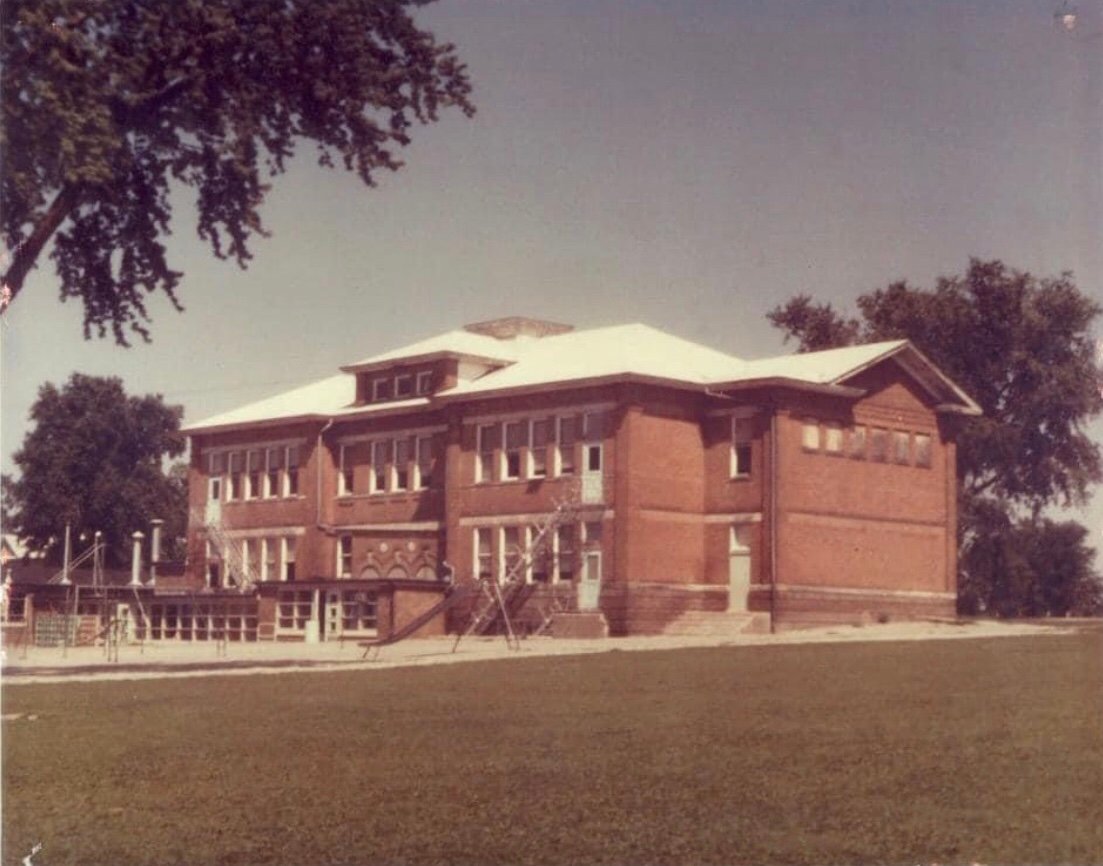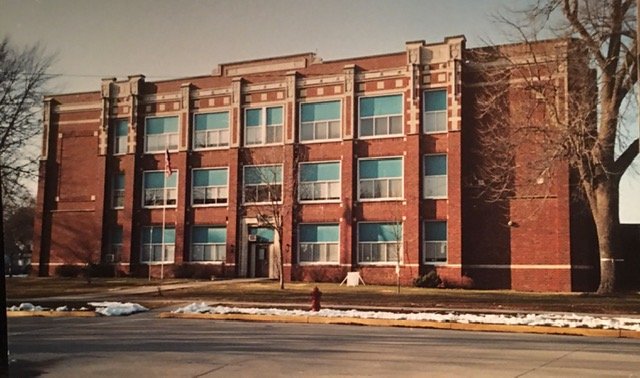West Liberty School District history
For this week’s column, I have researched the history of the West Liberty school system.
The first school was located west of the original town, in a groove of trees. It was at the edge of a small brush thicket near where Preston Brown’s farm later stood.
L.O. Mosher wrote this account of the school: ‘The site of the first schoolhouse built west of the Cedar River in Muscatine County was erected in 1839. It was made of logs cut from the forest that surrounded it. The cabin had a clapboard roof which was held on by the weight of the logs laid crosswise on the top of it. The first teacher was Valentine Bozarth, in the winter of 1839-1840. Later teachers were Vienna Winchester and Adela Humphreys. Adela married John Lewis, and then she no longer taught school’.
It goes without saying that the log cabin was very, very cold. The door was also comprised of clapboards on wooden hinges, which squeaked like a hand organ when the door was opened, it’s been written.
In these very early schools, many everlasting customs were founded. For noon lunch the children ate cornbread and fatty meat. They warmed themselves by chasing rabbits around the room. These rabbits would inevitably tear up the flooring. After lunch, Bozarth would have to wait until they captured the rabbit, and then put the floor back in place before school could resume.
In 1840, Elijah Younkin and S.T. Chesebro opened another select school nearby.
As the population of the settlement increased, many country schools were built in locations that would serve the children of the surrounding farms.
The first regular public school was established by Asa Gregg, about forty rods west of Bozarth’s school.
This school opened about 1843 in a comfortable frame building which was later moved to West Liberty and is believed to have become part of an elevator building.
The next public schools for which more is known were located on Spencer Street. One, referred to as the ‘little school’, stood where the George Schafer residence was. The unpainted school was a small one-story building of only one room, 25x40 feet. There were windows on two sides, but on the ends there were none. The entrance was through a small lobby where caps and wraps were put, and also where the water pail and dipper were kept.
One of the first teachers of this school was Mary Minnick, a Quaker lady. It was mostly a school for beginners. The Polders children were among the first pupils to attend this school.
One day, Amelia Polders recalled, when she was inside studying, a band of Indians came to the school and wanted everything they could see, even the pupils’ clothes. After many refusals of their requests, they were persuaded to leave peacefully.
Next to the little school on Spencer was a larger school. It was two stories high, but had only one room on the ground floor. Some of the teachers employed at this school were Miss Childs, Etta Raymond and Cina Ingham.
For a short time, the old Presbyterian chapel was used for school purposes. It is also generally agreed that a school stood in the vicinity of the Flora Hinkhouse home near the church, but no definite information is available.
During the 1850s, several other school locations were established in the town of West Liberty. In 1864 the West Liberty schools became an independent district with two teachers employed. Their salary was $25 per month each. Each teacher had about twenty-five students.
In 1868, a school on present day West Seventh Street was constructed, for grade school and high school students. In 1871 a west wing was added, and in 1873 an east wing was added. The first commencement was held in May of 1875, with two graduates: Miss Wilma Evans and Miss Emma Henderson. Although their diplomas did not arrive in time, the girls had their commencement anyway. Each gave her oration, which was a custom of this time period.
During this time period, most of the boys were working in the fields and therefore did not finish high school. In later years, there were a few town boys graduating from high school, however.
Less than two years after the first commencement, the number of high school students increased to a number which demanded more space and equipment. Subsequently, in 1877 the east building was erected as a high school and grammar school, for a cost of $6,000. It’s believed that once built, the grammar students studied on the first floor, and the high school students on the second floor.
From that point forward, the curriculum of the school was improved and added to, as the school’s enrollment increased. Student organizations and societies were developed, and the activities of the school were numerous. Popular among organizations were the literary societies. Along with these improvements, the number of faculty increased.
In 1879, sixteen people graduated. There were no graduates in 1881 or 1882.
It’s written "It often happened that as graduation grew near, students packed up their books and left school. It’s suggested that possibly the thought of writing an oration for graduation caused them to quit."
After 1882, there were regular commencements. They were held in the Opera House on Third Street downtown, and were comprised of two evening sessions. Each graduate had to give a talk on a subject of his choosing. In addition, a representative of the previous class would come back for a talk, and a well-known speaker would give a long oration. Then they’d all sing the class song before diplomas were passed out. Tickets were sold to the public to reserve seats for the two evening events. The money was donated to the high school library.
In 1887, the first reference library was started with the purchase of Johnston’s Encyclopedia.
At a school board meeting in July 1897, Professor Hill made the request that the schools be divided into three divisions: grades 1-4 as primary; grades 5-8 as intermediate; and grades 9-12 as high school. This motion was approved.
In 1905 the crowded conditions of the schools made it imperative to either remodel and enlarge the school, or to build a new school. After much discussion, it was decided to rebuild the west building as a high school, and to repair the east building for grade school use. As a result of this, the west building was equipped with the best of heating plants, new plumbing, and in 1907, electric lights added.
In addition, two fire escapes were added and a telephone installed. Shade trees were planted, a well dug, and a board fence built to replace the rail fence.
In the spring of 1912, a frame building was erected in the front yard of the west school building to make room for all the modern equipment in the new courses of home economics and agriculture. This building was commonly referred to as the "sheep shed." Miss Ossie Wilson was the first home ec teacher, and Ray A. Bell was the first ag teacher.
According to historian Elsie Holmes, in the spring of 1912 the school board was notified that the school would be designated as a Normal Training high school, and eligible to receive state aid. The superintendent of this time period, Macy Campbell, later became well-known not only statewide but nationally as a progressive educator. Campbell was very influential in bringing about additions to the course of study at West Liberty, specifically home ec (then referred to as domestic science), and agriculture.
Elsie wrote "This put West Liberty in the forefront of high schools adopting vocational education."
By 1914, the high school faculty consisted of nine teachers and the superintendent.
Tragically, in January 1916 a fire completely destroyed the east building. After the fire, locations for the displaced students to attend classes were secured. Some went to the theatre, some to church basements and other places around town.
An architect was soon hired to draw up plans for a new building with all the latest equipment. A bond issue was put to the voters, and it passed. Bids went out immediately. Construction began in the late spring and was not finished until 1918 when students arrived in the fall. All the grade school students moved to the west building that year.
In 1921, the Independent District of West Liberty was offlically established, with the districts of Prairie Grove, North Prairie and Hartupee Independent consolidating with West Liberty.
That year also marked the beginning of bus transportation for the schools. The school purchased a motorized school bus, a 1921 International model made in Clinton.
Jay Hinkhouse was the first bus driver. At the time of the purchase, A.L. Dice was president of the school board. The bus body was made of oak that was finished with varnish. Passengers boarded through the rear door, and sat on leather upholstered seats that were parallel to the sides of the bus. It held twenty passengers. This bus was used for the next ten years, before it was traded in on a new model.
In 1938, kindergarten was added to the elementary grades. In 1947 work started at the site of the Memorial Athletic Field. Up until that time, football games had been played at the fairgrounds.
In 1953, an addition was built to the grade school to help solve the crowded conditions. It included six classrooms, a gym, offices and a kitchen.
By 1954, high school students could walk to the grade school and have a hot noon lunch.
In 1957, Atalissa joined the West Liberty school system, and Nichols joined in 1968.
In 1957, the school district bought up lots to expand the high school, and sold them off to clear them for construction. Earl and Elsie Jehle’s Lunchroom sold for twenty dollars. Eph Fenstermaker had a barn and a house; the barn sold for twenty-seven dollars and the house for $1,000.
The voters approved the bond issue of $395,000 to build the addition. It included the "finest and most modern gymnasium, as well as a vocational agricultural section."
The classrooms and gym were completed in 1958, and were in use that fall.
As the crowding situation at the elementary level continued, with fourth graders being bused to Nichols or Atalissa for a period of time, more changes needed to be made.
In 1965, a new middle school was proposed and voted on, and the $610,000 bond passed. It was to be located on Miller Street and would be for grades 5-8. Construction was to begin in what was at the time a pasture for milk cows. To help save money on the project, volunteers from the community, including the West Liberty Lions Club, the West Liberty Fire Department, the school board, school custodians, and others joined forces to clear rubbish, take down fences, haul posts to burn, cut down trees and even remove a cement silo.
In August 1976, a Muscatine Journal article titled "Final Days For West Elementary" was published. Here are some excerpts:
"Some students at West Elementary school here will be making history when they attend classes this year. Classes started on Wednesday and for the oldest portion of the West Elementary building it will be the last year, the final phase in a long tradition in West Liberty education."
"After over one hundred years of housing school students, old West will be replaced by new facilities this year. A new wing is scheduled for construction beginning this fall, and upon its completion the two-story portion dating from 1868 will be razed."
"In the meantime one more segment of the present generation will sit in the high ceilinged classrooms, surrounding by walls, which today can’t hide the crumbling plaster and are characterized by the traditional picture of George Washington."
"According to Superintendent Delmar Jeneary, the old building has become a fire hazard. In recent presentations to the public, supporters of the new school addition stressed dangers of wooden stairwells and floors."
"Furthermore, the structure of the building has given way to age and decay."
The old school was demolished in 1977, after serving West Liberty students for one hundred nine years.
The new addition, adjacent to the 1953 wing, would include four second grade classrooms, four third grade classrooms, a kindergarten room, library, music, art and bilingual rooms, remedial reading, conference and speech and hearing areas, and a teacher’s workroom and restrooms.
This addition is now known as the Early Learning Center. Today it houses pre-kindergarte and kindergarten classes.
With the end of the baby boom babies reaching school age, enrollment finally did drop for a while.
The most visible change in the curriculum over the years has undoubtedly been the use of the computer. By 1988 there were eighty computers dispersed in both lab situations and individual classrooms. The yearbook and newspaper staffs used word processing and graphics, while vocational departments taught computerized accounting, computer assisted drafting, and data management and retrieval.
Remodeling was done to facilitate the restructuring in the late 1980's, resulting from the closing of the Nichols building, the addition of all day kindergarten, and the reinstatement of elementary art.
In 2005, the long debated new high school opened on Maxson Avenue. The class of 2005 was the first to graduate at the new building. The 1918 building on Seventh Street was demolished about that time. A new middle school was then built on this site, with the original middle school on Miller Street becoming an elementary school.
Comments






